At some point in the last few months, I hinted that I’d be trying something new this year for the notebook that I use for my job. After many years of consistently using large-ish wire-o bound notebooks (see examples in these posts: Finishing a Work Notebook , My Latest Work Notebooks, New Job, New Notebook), last year I used a pocket size Pagem planner (see 2024 Pagem Planner Review) and quite enjoyed it. It made me realize I could make do with a smaller page size, and since I had a nice pocket size Filofax that I wanted to use more actively, (see Vintage Filofax Modification) I decided to make that my work notebook for 2025.
I bought a calendar insert for the pocket Filofax and already had it sitting on my desk, eager and ready to go… but the more I thought about it, the more I started to realize that a pocket Filofax page layout might just be too small. You can see below how it compares to the Pagem layout I was using.
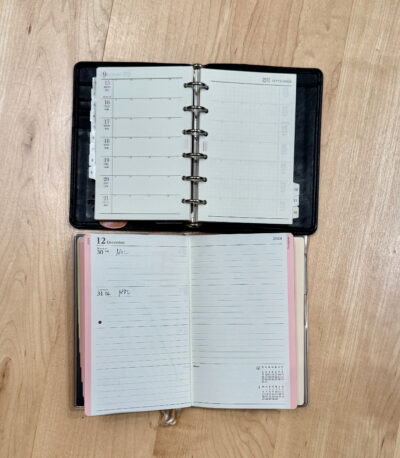
Since I only work 3 days a week, I wasn’t too worried about fitting in all my daily appointments, but I do tend to have a long list of to-do items that goes on the facing page, and it started to feel like that wouldn’t work. Though I’d like to be the kind of person who accomplishes all her tasks and never has more to do than my tiny handwriting could cram into that size page, I’m not. I do procrastinate about certain things and tend to have long-term items that gather up and get rolled over from week to week, so the pocket Filofax layout felt like it would be cramped.
I also wanted to keep my notes for meetings and projects in the same notebook. One of the nice things about a refillable notebook was that I’d be able to move pages around, filing meeting notes in a section devoted to a particular project, or perhaps inserting them within a particular week of the calendar. When I’m rapidly scribbling notes during a meeting, my handwriting gets bigger and messier, and I need more space. That was a major reason why I was always using notebooks that were at least 7×9″ all those years. When I was using the Pagem planner, I wrote some notes in the blank pages at the beginning and end, but I ended up having a separate desktop notebook that I used for meeting notes.
So I was in this dither about what to do, but then I had an epiphany when I was playing with my friend’s Filofax Winchester from the 1980s: moving up to a personal size Filofax would give me the space I needed.
Ever since buying my first pocket Filofax in the early 1990s, I’d never really given much thought to the larger models. They seemed too big to carry around, and I didn’t care for the snap fasteners. And I’m just too loyal to my favorite size! But I did appreciate the beautiful leathers they were made with, and I remembered noticing that some of them had cute, tiny pockets for stamps. While researching older Filofaxes, I realized that there were some personal size models that didn’t have snap fasteners. So I set my sights on what I thought would be the perfect Filofax for my purposes, and I managed to buy one: the Gloucester, from the mid-1980s.
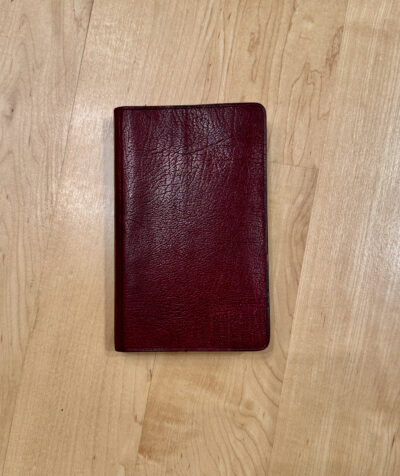
This Filofax Gloucester is what they’d now call a “compact” model, because it has half-inch rings, rather than the more typical 7/8″ rings found on most personal size organizers. One side has the little stamp pockets, and on the other side, there are two full length pockets, one gusseted. This design seems to have been around for a while before the 1980s heyday of Filofax organizers– in the catalog archive at Philofaxy, an early version with model #A299 is shown in a 1979 catalog. The A299 model number also appears, described with the same features, in a catalog estimated to be from 1937, though there is no picture. In the 1984 catalog, the Gloucester is noted as being a “traditional design.”
The nice thing about this Filofax is that the branding and model number (updated in the ’80s to 6CL1/2, for 6 pockets, made of CaLf leather, and 1/2″ rings) is stamped on it sideways, and the pockets all run sideways, so you can decide for yourself which pockets you want in the front or the back and it will never be upside-down. This one is in very good used condition–there are signs of wear, but it was well cared for and the minor scuffs and stains don’t bother me in the least. The leather is elegant but also quite thick and rugged– I don’t know if anyone even makes small leather goods with materials of this quality anymore, and if they do, I’m sure they cost a fortune.
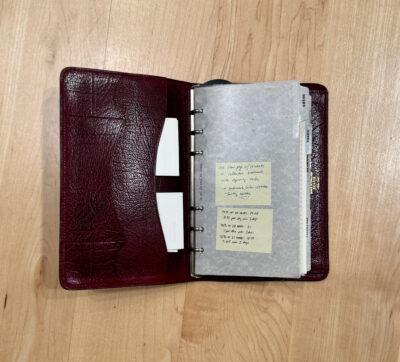
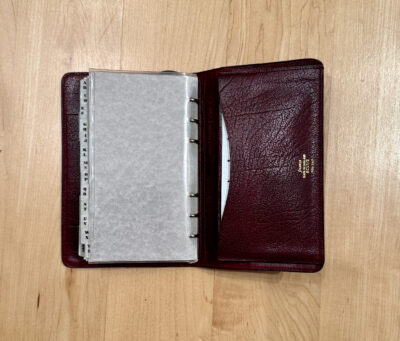
For inserts, I got myself a Plotter bible size calendar and grid paper pad, and also decided to try some RayMay DaVinci paper. The dividers are original Filofax dividers from the early 1990s. The half-inch rings are quite full with this set up, so I may end up removing the alphabetized address section. (After writing this post, I realized that the calendar included extra weekly pages for the first 3 months of 2026, so I took those out to make a little more room.) I’ve been keeping the Plotter grid pad on my desk– the nice thing about Plotter papers is that they’re glue-bound like a notepad. It’s sometimes handy to be able to write on the top sheet of the pad, and then insert it in the ring binder afterwards.

The calendar layout gives me room for the work week on the left, and a blank page for to-do’s on the right. I put a sticky note on the ruler that aligns with my work days and reminds me of standard repeating tasks for those days. I love Plotter’s aesthetic, but I kind of wish this calendar was designed a bit differently. Mainly I just wish each spread spelled out the name of the month instead of just having a “1” in the corner for January, etc., but I’d also prefer a more clear layout– still minimal, but without some of the little marks and icons.
I keep blank paper for random notes in the “notes” section. I have a page each for various repeating meetings and ongoing projects in the “projects” section. In “information” I have a list of passwords and some other reference pages. The “financial” section is empty, and so far, the addresses section is empty. But I may add some contact info there. And maybe move my meetings and projects to the alphabetized sections so I can jump to particular pages more easily.
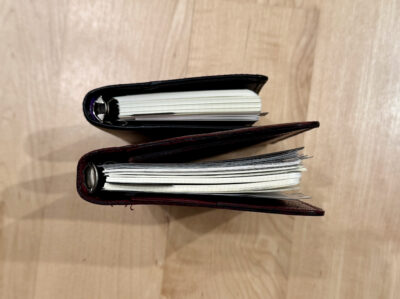

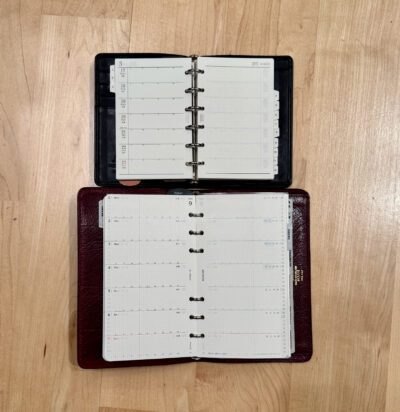
The Gloucester looks huge next to my pocket Grosvenor, but it’s actually not that big. The whole thing fits nicely on my desk and lies open pretty flat– I think it will lie even flatter as I break it in with more use. I love the slim size and it will be nicely portable on the rare occasions that I’m working somewhere other than home. But I do wish I had room for more pages, so I may consider archiving the calendar pages for past weeks, or using a different, thinner calendar next year. If I end up deciding I need more space, I may try another Filofax with larger rings. Maybe I’ll even go further out of my comfort zone and consider one with a pen loop and fastener! [gasp]
It’s only been a couple of weeks, but I think I’m going to be really happy with this set-up– it already feels like a very functional and well-organized work notebook. I don’t know what took me so long to try it!


Its kind of funny, I’m using the opposite setup for work. I’m using a plotter binder with filofax inserts (monthly & weekly). Its a 6 ring pocket size binder that’s good for weekly project notes and to-dos. I use a separate A5 notebook for meeting notes. Its a kokuyo sooofa in an A5 systemic. I really like that setup for note taking. As a lefty, I appreciate those soft rings.